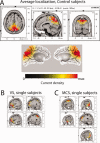Cortical source of blink-related delta oscillations and their correlation with levels of consciousness
- PMID: 22431380
- PMCID: PMC6870264
- DOI: 10.1002/hbm.22056
Cortical source of blink-related delta oscillations and their correlation with levels of consciousness
Abstract
Recently, blink-related delta oscillations (delta BROs) have been observed in healthy subjects during spontaneous blinking at rest. Delta BROs have been linked with continuous gathering of information from the surrounding environment, which is classically attributed to the precuneus. Furthermore, fMRI studies have shown that precuneal activity is reduced or missing when consciousness is low or absent. We therefore hypothesized that the source of delta BROs in healthy subjects could be located in the precuneus and that delta BROs could be absent or reduced in patients with disorders of consciousness (DOC). To test these hypotheses, electroencephalographic (EEG) activity at rest was recorded in 12 healthy controls and nine patients with DOC (four vegetative states, and five minimally conscious states). Three-second-lasting EEG epochs centred on each blink instance were analyzed in both time- (BROs) and frequency domains (event-related spectral perturbation or ERSP and intertrial coherence or ITC). Cortical sources of the maximum blink-related delta power, corresponding to the positive peak of the delta BROs, were estimated by standardized Low Resolution Electromagnetic Tomography. In control subjects, as expected, the source of delta BROs was located in the precuneus, whereas in DOC patients, delta BROs were not recognizable and no precuneal localization was possible. Furthermore, we observed a direct relationship between spectral indexes and levels of cognitive functioning in all subjects participating in the study. This reinforces the hypothesis that delta BROs reflect neural processes linked with awareness of the self and of the environment.
Keywords: blinking; consciousness; delta rhythm; event-related oscillations EROs; event-related potentials ERPs; precuneus.
Copyright © 2012 Wiley Periodicals, Inc., a Wiley company.
Figures



References
-
- Baars BJ, Rams⊘y TZ, Laureys S (2003): Brain, conscious experience and the observing self. Trends Neurosci 26:671–675. - PubMed
-
- Balazs S, Stepan C, Binder H, von Gizycki H, Avitable M, Obersteiner A, Rattay F, Selesnick I, Bodis‐Wollner I (2006): Conjugate eye movements and gamma power modulation of the EEG in persistent vegetative state. J Neurol Sci 246:65–69. - PubMed
-
- Bates AT, Kiehl KA, Laurens KR, Liddle PF (2009): Low‐frequency EEG oscillations associated with information processing in schizophrenia. Schizophr Res 115:222–230. - PubMed
-
- Berg P, Davies MB (1988): Eyeblink‐related potentials. Electroencephalogr Clin Neurophysiol 69:1–5. - PubMed
MeSH terms
LinkOut - more resources
Full Text Sources

